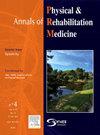The immediate effect of swimming stroke on pain in people with chronic low back pain: a crossover study
IF 4.6
3区 医学
Q1 REHABILITATION
Annals of Physical and Rehabilitation Medicine
Pub Date : 2025-09-29
DOI:10.1016/j.rehab.2025.102030
引用次数: 0
Abstract
Background
Swimming is anecdotally suggested as a suitable exercise for chronic low back pain. However, swimming involves different strokes that require different movement patterns and, therefore, may impact low back pain symptoms differently. The extent to which different swimming strokes impact chronic low back pain differently is currently unknown.
Objectives
This study compares and describes the intensity of pain experienced during and immediately after different swimming strokes in individuals with chronic low back pain.
Methods
We recruited 30 adults with chronic low back pain. Participants swam 100 m of freestyle, breaststroke, and backstroke in a balanced, randomized sequence. The primary outcome was pain intensity during swimming, measured as average and worst pain (0–10 Numeric Pain Rating). Secondary outcomes included pain after swimming while standing and while completing an aggravating movement. Pain scores were compared between strokes using linear mixed-effects models that included a fixed effect of stroke and period, and a random effect for participant. Carry-over effects were investigated via a stroke-by-period interaction.
Results
There was no evidence of carry-over effects for any outcome measure (P >0.15). Backstroke had lower average pain compared to breaststroke (mean difference, MD −0.63; 95% CI: −1.17 to −0.10) but was not different to freestyle (MD −0.27; 95% CI: −0.80 to 0.27), and lower worst pain compared to breaststroke (MD −1.10; 95% CI: −1.77 to −0.43) but was not different to freestyle (MD −0.60; 95% CI: −1.27 to 0.07). Standing pain had a similar pattern to the primary outcomes, but pain with an aggravating movement showed no statistically significant differences.
Conclusion
Backstroke was the least painful swimming stroke during and immediately after swimming when compared to breaststroke, and to a lesser extent, freestyle. The average differences were typically small but may be important to the long-term effects. Swimming stroke should be considered by health professionals when prescribing an individualized swimming program.
Trial registration: This study was registered in the Australian New Zealand Clinical Trials Registry (Trial ID: ACTRN12624000263594).
游泳对慢性腰痛患者疼痛的直接影响:一项交叉研究
游泳是一种适合治疗慢性腰痛的运动。然而,游泳涉及不同的泳姿,需要不同的运动模式,因此,对腰痛症状的影响也不同。不同的游泳方式对慢性腰痛的影响程度目前尚不清楚。目的:本研究比较并描述了慢性腰痛患者在不同游泳动作期间和之后的疼痛强度。方法我们招募了30名患有慢性腰痛的成年人。参与者按随机顺序游100米自由泳、蛙泳和仰泳。主要结局是游泳时的疼痛强度,以平均疼痛和最严重疼痛来衡量(0-10数值疼痛评分)。次要结果包括站立游泳和完成加重运动后的疼痛。使用线性混合效应模型比较卒中之间的疼痛评分,该模型包括卒中和周期的固定效应,以及参与者的随机效应。通过逐期相互作用研究了携带效应。结果没有证据表明任何结局测量存在结转效应(P >0.15)。与蛙泳相比,仰泳的平均疼痛较低(平均差异,MD - 0.63; 95% CI: - 1.17至- 0.10),但与自由泳没有差异(MD - 0.27; 95% CI: - 0.80至0.27),与蛙泳相比,最严重的疼痛较低(MD - 1.10; 95% CI: - 1.77至- 0.43),但与自由泳没有差异(MD - 0.60; 95% CI: - 1.27至0.07)。站立疼痛与主要结果有相似的模式,但加重运动时的疼痛没有统计学上的显著差异。结论与蛙泳相比,仰泳在游泳过程中和游泳后的疼痛程度最低,自由泳的疼痛程度较低。平均差异通常很小,但可能对长期影响很重要。健康专家在制定个性化的游泳计划时应考虑到游泳中风。试验注册:本研究已在澳大利亚新西兰临床试验注册中心注册(试验ID: ACTRN12624000263594)。
本文章由计算机程序翻译,如有差异,请以英文原文为准。
求助全文
约1分钟内获得全文
求助全文
来源期刊

Annals of Physical and Rehabilitation Medicine
Medicine-Rehabilitation
CiteScore
7.80
自引率
4.30%
发文量
136
审稿时长
34 days
期刊介绍:
Annals of Physical and Rehabilitation Medicine covers all areas of Rehabilitation and Physical Medicine; such as: methods of evaluation of motor, sensory, cognitive and visceral impairments; acute and chronic musculoskeletal disorders and pain; disabilities in adult and children ; processes of rehabilitation in orthopaedic, rhumatological, neurological, cardiovascular, pulmonary and urological diseases.
 求助内容:
求助内容: 应助结果提醒方式:
应助结果提醒方式:


